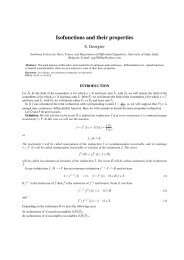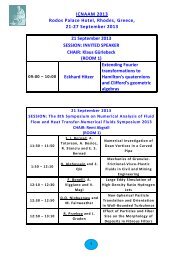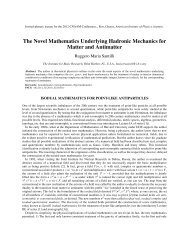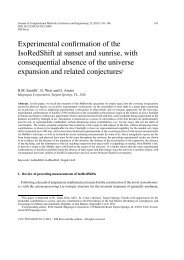A new electronic theory of pericyclic chemistry and aromaticity is ...
A new electronic theory of pericyclic chemistry and aromaticity is ...
A new electronic theory of pericyclic chemistry and aromaticity is ...
You also want an ePaper? Increase the reach of your titles
YUMPU automatically turns print PDFs into web optimized ePapers that Google loves.
170 M.O. Cloonan / International Journal <strong>of</strong> Hydrogen Energy 32 (2007) 159–171F 2F 2F 2F 229F 2F 2Fig. 13. Perfluorotetracyclobutacyclo-octatetrene ring system 29.explain the low reactivity <strong>of</strong> benzene relative to alkenes <strong>and</strong>the tendency to undergo substitution reactions as opposed toaddition <strong>and</strong> it <strong>is</strong> the RCEDGD stability <strong>of</strong> the ADEP processthat <strong>is</strong> predicted as the major factor as opposed to delocal<strong>is</strong>ation.Considering the high efficiency <strong>of</strong> the ADEP processthe continuous process <strong>is</strong> expected to be rapid. Evidence thatthe ADEP process <strong>is</strong> extremely rapid <strong>and</strong> that its rate providesthe greatest source <strong>of</strong> stabil<strong>is</strong>ation in benzene <strong>is</strong> seen in the factthat present experimental techniques (e.g. NMR, X-ray crystallography),which are subject to a time scale, observe an equaldegree <strong>of</strong> electron density at each point along the benzene ring(they observe an average due to the high rate).Based on th<strong>is</strong> <strong>new</strong> chemical <strong>theory</strong>, systems with an evennumber <strong>of</strong> double bonds (4n <strong>is</strong>oelectrons), with the exception <strong>of</strong>cyclobutadiene (as electron paths cross in an SDEP process; seeSection 2.5), are predicted to exhibit a diamagnetic ring current(implies movement <strong>of</strong> <strong>is</strong>oelectron pairs) if an SDEP process<strong>is</strong> involved. Th<strong>is</strong> could be achieved, based on the logic <strong>of</strong> th<strong>is</strong><strong>theory</strong> (see Sections 2.1 <strong>and</strong> 2.6), by annulation with strainedrings such as the four membered rings or norbornene-type systems.A continuous SDEP syn FSED process explains why theplanar perfluorotetracyclobutacyclo-octatetrene ring system 29,(Fig. 13) which has eight electrons (n = 2), <strong>is</strong> diamagnetic(which violates Hückel’s rules) <strong>and</strong> why the system <strong>is</strong> delocal<strong>is</strong>ed(it <strong>is</strong> also planar) as suggested by the bond lengths (bondalternation <strong>is</strong> relatively small, a difference <strong>of</strong> 0.08Å) [46]. Th<strong>is</strong>will be referred to as SDEP-Aromaticity. The present quantumchemical methods predict that perfluorotetracyclobutacyclooctatetrene<strong>is</strong> a local<strong>is</strong>ed structure with a closed-shell singlet<strong>electronic</strong> configuration [47]. These quantum chemical calculationsalso predicts that a delocal<strong>is</strong>ed structure would bediradicaloid, a “d<strong>is</strong>joint” singlet diradical [47c]. CTOCD-DZ(modern Hartree–Fock methods) calculations [47c] predictthat the ring 29 has a paratropic ring current (antiaromatic), incontrad<strong>is</strong>tinction to the empirical data.Based on th<strong>is</strong> <strong>theory</strong> benzene <strong>is</strong> either a rapid equilibrium betweentwo 1,3,5-cyclohexatriene structures, <strong>and</strong> thus an averagestructure <strong>is</strong> observed by the present experimental techniques,or the single bond framework <strong>is</strong> constant. The former case <strong>is</strong>similar to the Kekulé model <strong>of</strong> benzene except that the Kekulémodel lacks an intimate mechan<strong>is</strong>m by which the electrons canmove [48]. The electron was not d<strong>is</strong>covered when Kekulé proposedh<strong>is</strong> model. Th<strong>is</strong> theoretical possibility involves valencetautomer<strong>is</strong>m (fluxional), via the ADEP syn FSED <strong>electronic</strong>mechan<strong>is</strong>m. The concept <strong>of</strong> having the single bonds equal <strong>is</strong>F 2F 2seen in the outer-sphere electron transfer mechan<strong>is</strong>m where thelowest energy pathway for electron transfer between complexesoccurs when the metal-lig<strong>and</strong> bond d<strong>is</strong>tances are the same [49].Considering that spectroscopy techniques are subject to a timescale (thus an average may be observed) <strong>and</strong> present analys<strong>is</strong><strong>of</strong> the spectroscopic data <strong>is</strong> strongly dependant on <strong>theory</strong> [50],it <strong>is</strong> not unequivocal to which <strong>of</strong> the two alternative proposals<strong>is</strong> valid. Th<strong>is</strong> <strong>and</strong> other features including ‘anti<strong>aromaticity</strong>’ willbe d<strong>is</strong>cussed in a future publication.As a final point it should be noted that the Cplex-<strong>is</strong>o<strong>electronic</strong><strong>theory</strong>, in its present qualitative form, <strong>is</strong> like all qualitative theories,prone to some degree <strong>of</strong> a posteriori rationalization insome cases. Th<strong>is</strong> can be seen, for example, in deciding whethera thermal reaction can occur via a concerted SDSE syn FSED<strong>electronic</strong> mechan<strong>is</strong>m or by a stepw<strong>is</strong>e pathway. Th<strong>is</strong> <strong>is</strong> notnecessarily a limitation in juxtaposition to the present theories,based on the following statement by Dewar “The problems <strong>of</strong><strong>chem<strong>is</strong>try</strong> cannot be solved, <strong>and</strong> will not be solved in the forseeablefuture, by a priori quantum mechanical calculation” [51].According to Dewar all present quantum methods, includingab initio method, are wholly empirical <strong>and</strong> the only way <strong>of</strong>d<strong>is</strong>covering which level <strong>of</strong> <strong>theory</strong> <strong>is</strong> sufficient <strong>is</strong> by comparingwith experiment [52]. Th<strong>is</strong> stems from the fact that it <strong>is</strong> impracticalto calculate an exact representation for complex chemicalsystems, especially chemical reactions, based on presentmethods <strong>and</strong> technologies. Some <strong>of</strong> these a posteriori rationalizationscan be removed when more knowledge about the experimentaldata, on which the assumptions are deduced from,<strong>is</strong> d<strong>is</strong>covered. On th<strong>is</strong> vein the emergence <strong>of</strong> Hadronic <strong>chem<strong>is</strong>try</strong><strong>is</strong> highly prom<strong>is</strong>ing as convergence occurs at least 1000times faster than the present C.I. calculations [1,2]. Furthermore,as Hadronic <strong>chem<strong>is</strong>try</strong> permits an exact quantitative representation<strong>of</strong> the chemical bond it can make <strong>new</strong> predictionsfor <strong>pericyclic</strong> reactions <strong>and</strong> aromatic compounds. Exploring thecons<strong>is</strong>tency between the predictions <strong>of</strong> the Cplex-<strong>is</strong>o<strong>electronic</strong><strong>theory</strong> <strong>and</strong> hadronic <strong>chem<strong>is</strong>try</strong> <strong>is</strong> for future study.References[1] Santilli RM, Shillady DD. Int J Hydrogen Energy 1999;24:943–56.[2] Santilli RM. Foundations <strong>of</strong> hadronic <strong>chem<strong>is</strong>try</strong>, with applications to <strong>new</strong>clean energies <strong>and</strong> fuels. Dordrect: Kluwer Academic Publ<strong>is</strong>hers; 2001.[3] Woodward RB, H<strong>of</strong>fmann R. Angew Chem Int Ed Engl 1969;8:781–853.[4] Fukui K. Angew Chem Int Ed Engl 1982;21:801–9.[5] Wiest O, Montiel DC, Houk KN. J Phys Chem A 1997;101:8378–88.[6] [a] Robinson R. Quatrieme Conseil de la Inst Chim Solvay 1931; 423;[b] Ingold CK. Chem Rev 1934;15:225–4.[7] Matsunaga N, Rogers DW, Zavitsas AA. J Org Chem 2003;68:3158–72.[8] [a] Gell-Mann M. The quark <strong>and</strong> the Jaguar: adventures in the simple<strong>and</strong> the complex. Abacus, 1995;[b] Bertz SH. New J Chem 2003;27:860–9.[9] [a] Dickstein JL, Miller SI. In: Patai S, editor, The <strong>chem<strong>is</strong>try</strong> <strong>of</strong> thecarbon–carbon triple bond part 2. New York: Wiley; 1978;[b] Abramovitch RA, Singer SS. J Org Chem 1976;41:1712–7;[c] Strozier RW, Caramella P, Houk KN. J Am Chem Soc 1979;101:1340–3.[10] Deslongchamps P. Stereo<strong>electronic</strong> effects in organic <strong>chem<strong>is</strong>try</strong>,Elmsford, New York: Pergamon; 1983.[11] [a] Magid RM, Fruchey OS. J Am Chem Soc 1979;101:2107–12;[b] La Cruz TE, Rychnovsky SD. J Chem Soc Chem Commun 2004;168–9;







